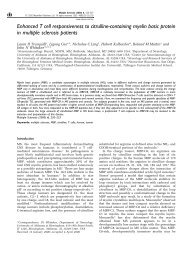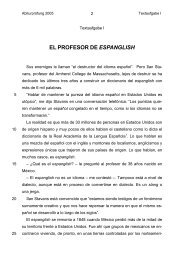Pathfinder Chronicles - Gazetteer - Asamnet
Pathfinder Chronicles - Gazetteer - Asamnet
Pathfinder Chronicles - Gazetteer - Asamnet
You also want an ePaper? Increase the reach of your titles
YUMPU automatically turns print PDFs into web optimized ePapers that Google loves.
<strong>Pathfinder</strong> <strong>Chronicles</strong><br />
36<br />
their missing master and seeding their particular style of<br />
arcane art throughout the continents.<br />
Then, in 2822, alien ships once more appeared on the high<br />
Obari and set anchor in the wave-ravaged harbor of Niswan.<br />
Hundreds of Vudrani rajahs embarked upon Jalmeray,<br />
curiously wondering at the audacity of the Arclords and<br />
their perversions of the changes Khiben-Sald had brought<br />
to the island. Was he not the greatest maharaja of Vudra,<br />
they asked? Did he not dwell upon Jalmeray at the bequest of<br />
Nex himself? The Vudrani nobles produced improbable but<br />
apparently accurate genealogical information proving their<br />
familial ties to Khiben-Sald, calmly inviting the Arclords<br />
to abandon their ancestral island home. When the stodgy<br />
wizards refused, the rajahs summoned an army of marids<br />
from the depths of the sea. They battered the island with<br />
relentless storms that sank all but one of the Arclords’<br />
ships. More than a thousand years after the departure of<br />
Maharajah Khiben-Sald, the Isle of Jalmeray once more<br />
belonged to Vudra.<br />
The Vudrani nobles immediately unsealed their ancient<br />
monuments and stirred their otherworldly guardians<br />
once more to life. Within decades, they established great<br />
monasteries upon the island, spreading word to the<br />
followers of Irori throughout the world of a new form of<br />
physical and mental discipline from the distant East. All<br />
who could survive the journey were welcomed to venture<br />
to Jalmeray and endure a series of seemingly impossible<br />
challenges. Those who thrived were accepted in one of<br />
three monasteries, there to develop physical mastery and<br />
an unusual magic of the mind.<br />
The challenge still stands centuries later, and those<br />
willing to brave a race against a djinn, wrestle a dao, and<br />
outwit an efreet are accepted into the monastic orders<br />
of Jalmeray to learn the secret arts of a distant people.<br />
Few residents of the Inner Sea understand these strange<br />
disciplines or the even stranger folk who teach them, but the<br />
adherents of the Impossible Kingdom command respect—<br />
if not trust—throughout the nations of the Inner Sea.<br />
Katapesh<br />
BAZAAR OF THE BIZARRE<br />
Alignment: N<br />
Capital: Katapesh (212,300)<br />
Notable Settlements: Okeno (13,700), Solku (4,900)<br />
Ruler: The Pactmasters of Katapesh<br />
Government: Anarchic plutocracy led by faceless, inhuman<br />
merchant league<br />
Languages: Kelish, Osirian, Common, Tien, Vudrani<br />
Religion: Abadar, Sarenrae, Nethys, Irori<br />
The legends say that a man can find anything in the<br />
teeming markets of Absalom, but on this topic the legends<br />
are wrong. For although the City at the Center of the World<br />
boasts some of the finest merchants and wares of Golarion,<br />
there are some items so illegal, so dangerous, so outright<br />
bizarre that they cannot be found there. For such quarry,<br />
a buyer must seek the offerings of Katapesh, home to the<br />
greatest (and weirdest) markets in all Golarion.<br />
The inhuman merchant council that rules Katapesh<br />
arrived out of nowhere in the Age of Destiny, carving out<br />
of a lawless region of desert coast an outpost for unusual<br />
and illicit trading with whomever ventured to their arid<br />
settlement. In time, the outpost grew into a town, then a<br />
city, and finally into a powerful nation with economic ties<br />
throughout the kingdoms of the Inner Sea.<br />
Members of Katapesh’s bizarre ruling caste cloak<br />
themselves in flowing garments that cover every inch of<br />
their 7-foot-tall, spindly frames. Garish masks conceal<br />
the pactmasters’ featureless faces and muff le their deep,<br />
alien voices. The pactmasters never leave Katapesh for any<br />
reason, dealing with outside nations through hired human<br />
intermediaries and friendly merchant princes. They<br />
sponsor no army and enforce few laws upon their citizens,<br />
nearly all of whom engage in some form of trade (much of<br />
it illicit). Their chief protectors are the Aluum, relentless<br />
golems powered by the eternally bound souls of aged slaves.<br />
Even life is for sale in Katapesh, which boasts the most<br />
lucrative and varied slave markets in the hemisphere.<br />
The fabulous wares of Katapesh bring travelers from<br />
throughout Garund and Avistan, attracting traders from<br />
far-off Vudra and Tian Xia. Some even come from other<br />
planes, and it’s not unusual to encounter a dwarven gemner,<br />
an ogre magi fleshcarver, and a gnoll slaver along the same<br />
stretch of street. The lax trade policies of the ruling elite (who<br />
actively participate in the markets) ensures that Katapesh<br />
offers delights and wares unavailable anywhere else in the<br />
multiverse. The pactmasters’ golems enforce the nation’s only<br />
law—that fighting must never get in the way of business.<br />
Perhaps Katapesh’s most dangerous export is pesh, a<br />
powerful narcotic derived from the spoiled milk of a rare<br />
cactus that grows in the interior deserts. Addicts from all<br />
corners of Garund and Avistan f lock to the pesh parlors<br />
of the capital to wallow in their disastrous and ultimately<br />
fatal indulgences.<br />
The walled town of Solku, in Katapesh’s western reaches,<br />
suffered an infamous siege 7 years ago when gnoll tribes<br />
surged from White Canyon and attempted to enslave the<br />
whole town. Paladins of Iomedae and the town’s battered<br />
militia finally turned back the savage humanoids at the<br />
Battle of Red Hail, and while gnolls remain welcome in<br />
the markets of the capital, in the hinterlands they are<br />
little trusted. The gnolls themselves, no longer content to<br />
raid for slaves in the southern deserts of Osirion on the<br />
other side of the mountains, frequently attack Katapeshi<br />
caravans and travelers in the wilderness. That these slaves<br />
are welcomed in the capital and the f lourishing slave
















